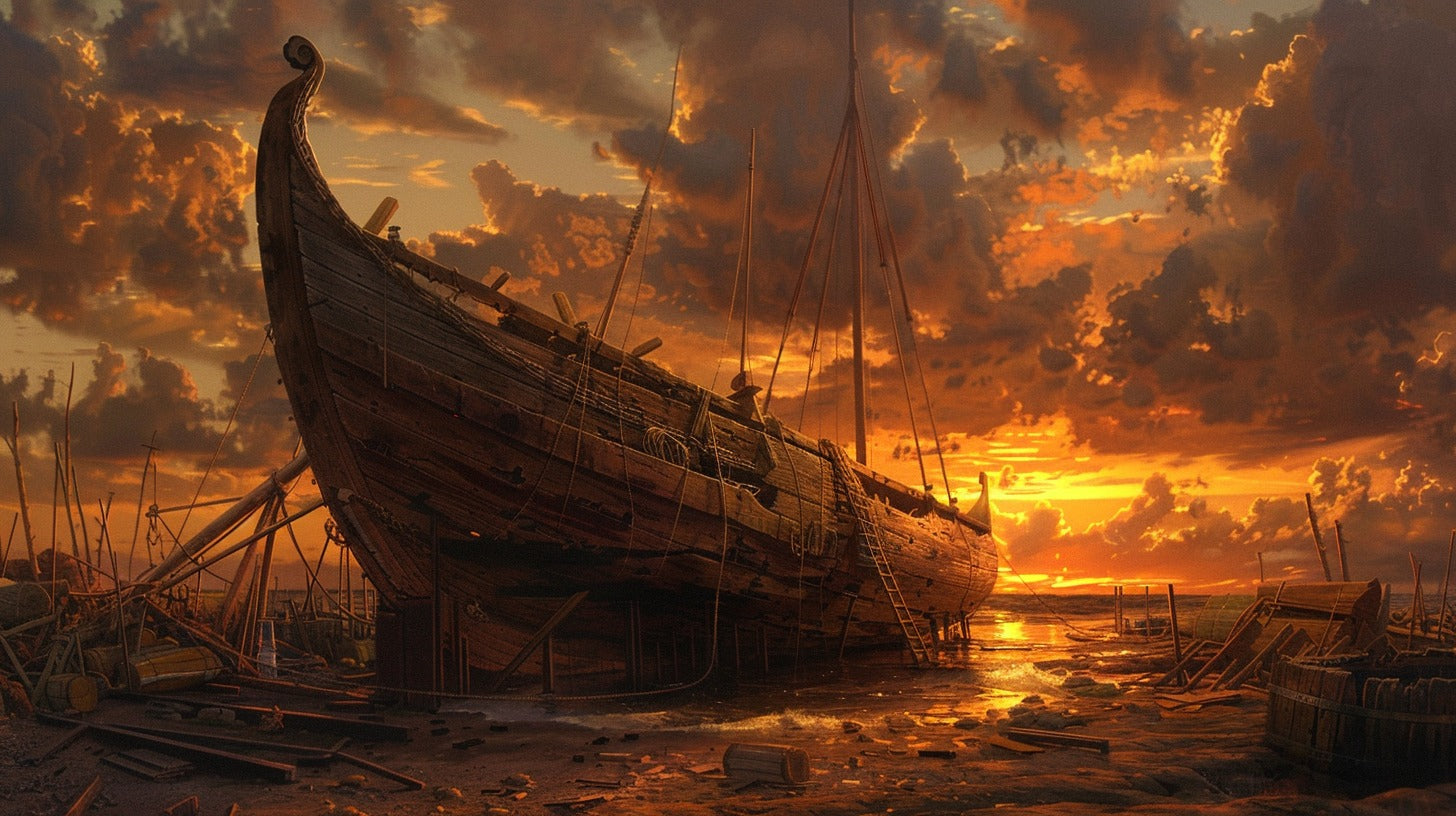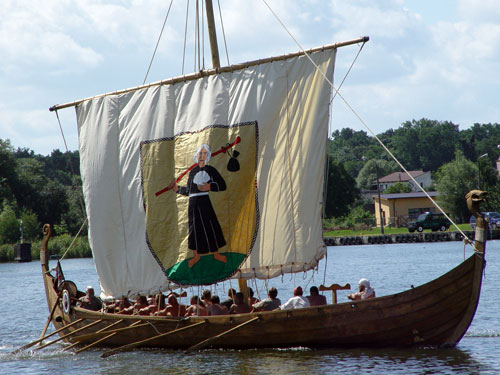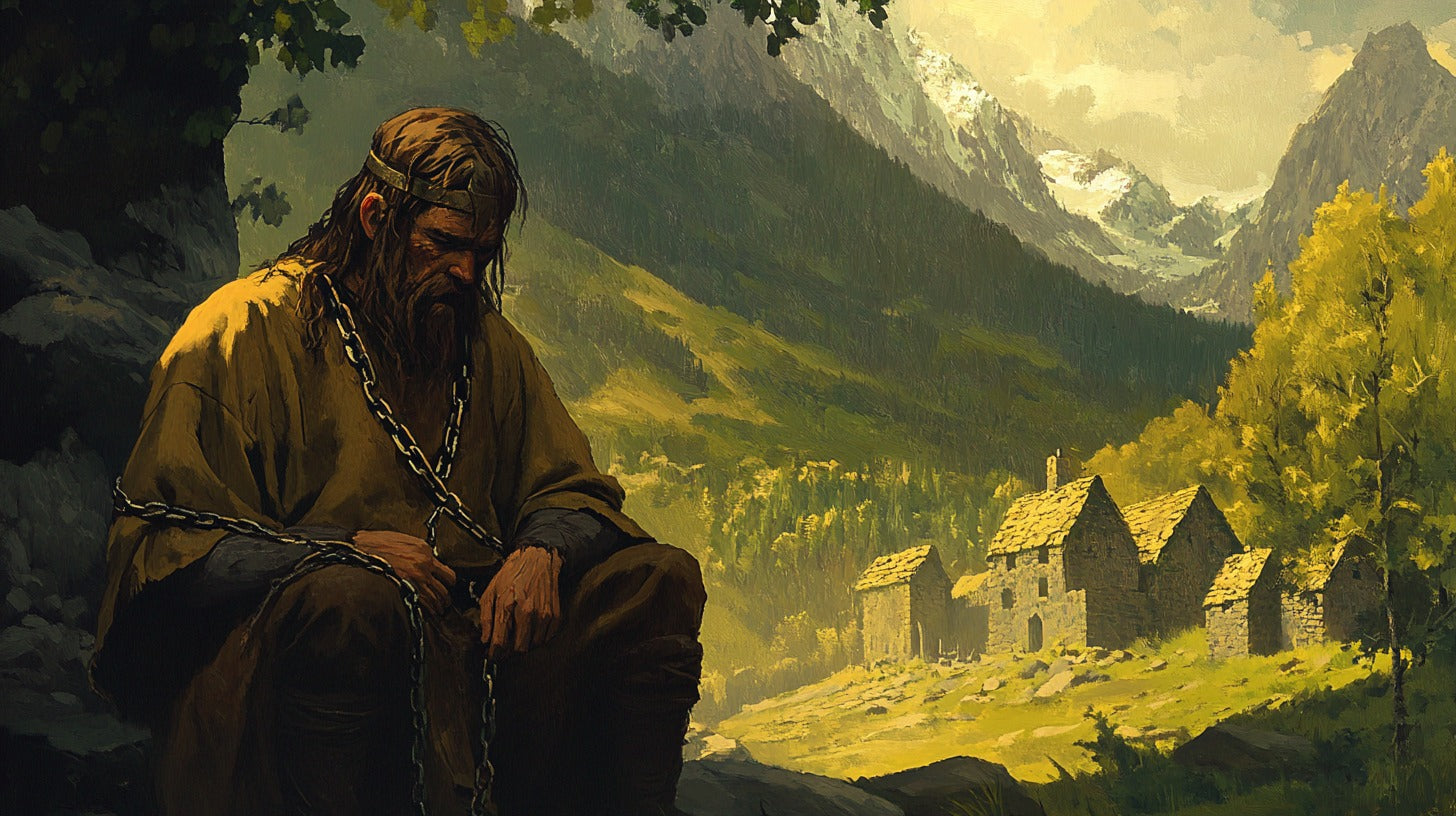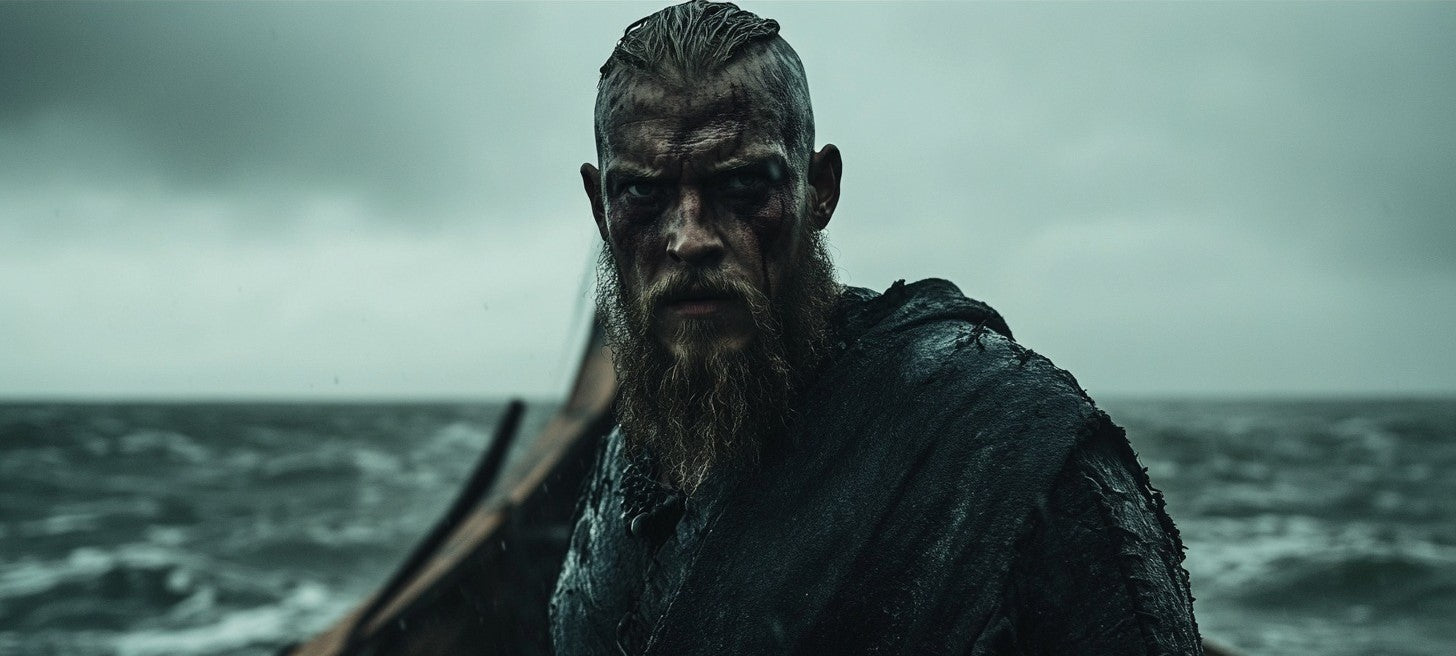
Masters of the Northern Seas: Viking Age Vessels and Their Legacy
In the mists of time, where legend and history intertwine like the intricate knotwork adorning the prows of ancient vessels, the Old Norse ships of the Viking Age stand as a testament to human ingenuity and the indomitable spirit of exploration. These wooden marvels, hewn from the forests of Scandinavia and shaped by the skilled hands of Norse shipwrights, were more than mere vessels; they were the lifeblood of a culture that would leave an indelible mark on the world.
The Evolution of Norse Shipbuilding
The story of Old Norse ships is one of continuous innovation and adaptation, a narrative that spans centuries and reflects the changing needs and ambitions of the Scandinavian people.

Early Scandinavian Vessels
In the dim recesses of pre-Viking history, the waters of the North were plied by simple vessels, not unlike those found in other parts of Europe. These early boats, often little more than hollowed-out logs or hide-covered frames, were the humble ancestors of the mighty ships that would one day carry Norse warriors and explorers to distant shores.
As the ancestors of the Vikings honed their seafaring skills, they began to experiment with more sophisticated designs. The transition from primitive watercraft to the advanced ships of the Viking Age was gradual, marked by incremental improvements in hull shape, propulsion methods, and overall seaworthiness.
Influence of Roman and Celtic Designs
The evolution of Norse shipbuilding did not occur in isolation. As trade and conflict brought the Scandinavians into contact with other maritime cultures, they absorbed and adapted foreign innovations to suit their unique needs.
The influence of Roman and Celtic shipbuilding traditions can be seen in certain aspects of Norse vessel design. The use of iron nails to fasten planks, for instance, was likely inspired by Roman techniques. Similarly, the graceful curves and animal-head decorations that would become hallmarks of Viking ships may have their roots in Celtic artistic traditions.
Types of Viking Ships
The popular image of a Viking ship often conjures up visions of fearsome longships with dragon-headed prows cutting through the waves. While these iconic vessels indeed played a crucial role in Norse maritime culture, they were but one type among a diverse fleet that served various purposes.

Longships: The Iconic Viking Vessel
The longship, with its sleek lines and shallow draft, was the pinnacle of Viking naval engineering. These versatile craft were equally at home on the open sea or navigating coastal waters and rivers. Their design allowed for both sailing and rowing, making them ideal for raids and long-distance voyages.
Drakkar: The Dragon Ship
The most famous of the longships was the drakkar, or dragon ship. These massive vessels, some reaching lengths of up to 30 meters, were often adorned with intricately carved dragon or serpent heads on their prows. More than mere decoration, these fierce visages were believed to ward off evil spirits and strike fear into the hearts of enemies.

The drakkar was a ship fit for kings and chieftains, a floating symbol of power and prestige. With their ability to carry large crews of warriors and their imposing appearance, these ships were instrumental in the Viking raids that would come to define an era.
Snekkja: The Nimble Warship
Smaller than the drakkar but no less formidable, the snekkja was a swift and agile warship. These vessels, typically ranging from 17 to 25 meters in length, were the workhorses of Viking fleets. Their shallow draft and maneuverability made them ideal for coastal raids and river expeditions.

Full-scale replica of a Viking snekkja based in Morąg, Poland / Photo: Jarmeryk
The snekkja's design struck a balance between speed and capacity, allowing it to carry a significant complement of warriors while still maintaining the agility needed for quick strikes and hasty retreats.
Knarr: The Merchant's Workhorse
While the longships captured the imagination of chroniclers and struck fear into the hearts of coastal inhabitants, it was the humble knarr that truly expanded the horizons of the Norse world.

Model of a knarr in the Hedeby Viking Museum in Germany / Photo: Grimhelm, CC BY-SA 3.0
These broad-beamed, deep-hulled vessels were built for long-distance trade voyages. With a capacity to carry up to 30 tons of cargo, knarrs were the backbone of Viking commerce. These sturdy ships braved the stormy North Atlantic, establishing trade routes that stretched from Scandinavia to the Mediterranean and beyond.
The knarr's design prioritized stability and cargo capacity over speed, featuring a wider hull and higher freeboard than its warship cousins. These characteristics made it well-suited for the tumultuous waters of the open ocean, allowing Norse merchants to transport goods, livestock, and settlers across vast distances.
Karvi: The Coastal Raider
Bridging the gap between the larger longships and smaller fishing boats was the karvi. These versatile vessels, typically featuring 13 to 16 pairs of oars, were well-suited for both warfare and trade along coastal routes.

The Tune viking ship in the Viking Ship Museum in Oslo / Photo: China Crisis, CC BY-SA 2.5
The karvi's modest size made it ideal for navigating fjords and coastal waters, while its seaworthiness allowed for longer voyages when necessary. These ships played a crucial role in the early stages of Viking expansion, facilitating both raiding and trading activities along the coasts of Northern Europe.
Construction Techniques and Materials
The mastery of shipbuilding techniques was a cornerstone of Viking culture, elevating the craft to an art form that combined practicality with aesthetic beauty.

Clinker-Built Hull Design
At the heart of Norse shipbuilding was the clinker-built (or lapstrake) construction method. This technique involved overlapping planks of wood, creating a hull that was both lightweight and flexible. The resulting structure could flex with the waves, making the ships more resilient in rough seas.
The planks were typically made from oak, a wood prized for its strength and durability. These planks were carefully shaped and fitted together, with the overlapping edges secured using iron rivets. The gaps between planks were caulked with tarred wool or animal hair, ensuring a watertight seal.
This clinker-built design was a marked improvement over the earlier Nordic boat-building techniques and would influence shipbuilding throughout Northern Europe for centuries to come.
The Art of Shipwright Craftsmanship
Building a Viking ship was a labor-intensive process that required great skill and experience. The shipwrights of the Norse world were highly respected artisans who passed their knowledge down through generations.

Close up of the Gokstad ship's prowl
The construction of a ship began with the laying of the keel, the backbone of the vessel. From this foundation, the shipwright would gradually build up the hull, carefully shaping each plank to fit precisely with its neighbors. The ship's ribs, providing internal structure and support, were added after the hull was completed.
The mast, typically made from a single tree trunk, was a critical component that required careful selection and preparation. The sail, woven from wool and treated with animal fat for waterproofing, was a valuable asset often passed down as an heirloom.
Navigation and Seamanship
The Vikings' mastery of shipbuilding was matched by their prowess as sailors and navigators. Their ability to traverse vast stretches of open ocean at a time when most European sailors hugged the coastlines was nothing short of revolutionary.
Viking Navigation Tools
Contrary to popular belief, the Vikings did not rely solely on the sun and stars for navigation. While these celestial bodies certainly played a crucial role, Norse sailors employed a variety of tools and techniques to find their way across the seas.

Animal head post for a longship's prowl, located in the Viking Ship Museum, Oslo, Norway / Photo: William Allen, CC BY-SA 2.0
One such tool, according to some Old Norse sagas, was the supposed sólarsteinn, or sunstone, a crystal believed to have been used to determine the position of the sun on overcast days. By observing the polarization of light through the crystal, skilled navigators could locate the sun's position even when it was obscured by clouds.
Another important navigational aid was the Norse compass, or "bearing dial." This device, consisting of a wooden disk marked with the cardinal directions, was used in conjunction with known landmarks and the position of the sun to maintain course.
Sailing Techniques in Harsh Northern Waters
The waters of the North Atlantic and Arctic were unforgiving teachers, and the Vikings learned to read the seas with an intimacy born of necessity. They became adept at interpreting subtle changes in wind patterns, ocean currents, and the behavior of sea birds to gauge their position and predict weather conditions.
The square sail of the Viking ship, while simple in design, was remarkably efficient when handled by skilled sailors. By adjusting the sail and using the ship's steering oar, Norse mariners could sail surprisingly close to the wind, a capability that expanded their range and options at sea.
In the narrow fjords and coastal waters of Scandinavia, Viking ships often relied on oar power. The coordinated efforts of the rowers, guided by the rhythmic beat of a drum or chanted song, could propel the ship with impressive speed and maneuverability.
The Role of Ships in Viking Society
To understand the significance of ships in Viking culture, one must look beyond their practical functions. These vessels were more than mere tools; they were the lifeblood of Norse society, shaping everything from economics to mythology.

Drakkar Longship Incense Burner
Symbols of Power and Prestige
In a culture where seafaring prowess was highly valued, ships became potent symbols of status and authority. The ownership of a great ship was a mark of wealth and influence, often serving as a floating hall where chieftains would hold court and forge alliances.
The importance of ships in Norse society is reflected in their prominence in art and literature. The intricate ship burials found at sites like Oseberg and Gokstad testify to the belief that great leaders should enter the afterlife aboard their prized vessels.
Facilitators of Trade and Exploration
While the longships may have garnered the most attention, it was the merchant vessels like the knarr that truly expanded the horizons of the Norse world. These ships facilitated a vast trading network that stretched from the fjords of Norway to the markets of Constantinople and beyond.
The ability to transport goods, livestock, and settlers across great distances allowed the Vikings to establish colonies in distant lands. From the Orkneys and Shetlands to Iceland, Greenland, and even North America, Norse ships carried not just people and goods, but entire cultures to new shores.
Famous Viking Voyages and Discoveries
The saga of Viking exploration is filled with tales of daring voyages and remarkable discoveries, many of which have passed into legend. Yet, archaeological evidence and historical records confirm that Norse sailors achieved feats of navigation that were unparalleled in their time.
The Settlement of Iceland and Greenland
One of the most significant achievements of Viking seafaring was the discovery and settlement of Iceland. According to the sagas, the first Norse settlers arrived on the island in the 9th century, led by explorers like Ingólfr Arnarson. The journey to Iceland, while perilous, became a well-established route, leading to the rapid colonization of the island.

Even more impressive was the Norse discovery and settlement of Greenland. Erik the Red, exiled from Iceland, led an expedition to this harsh and unforgiving land in 985 CE. Despite the challenges posed by the climate, Norse settlements in Greenland would persist for nearly 500 years.
Leif Erikson's Journey to Vinland
Perhaps the most famous of all Viking voyages is Leif Erikson's expedition to North America, a land he called Vinland. Around the year 1000 CE, Leif and his crew sailed west from Greenland, eventually making landfall on the coast of what is now Newfoundland.

The Norse presence in North America, while short-lived, represents a remarkable achievement of seamanship and exploration. The remnants of the Viking settlement at L'Anse aux Meadows in Newfoundland stands as tangible proof of this incredible journey across the Atlantic.
The Legacy of Old Norse Ships
The impact of Viking shipbuilding and seafaring extended far beyond the Norse world, influencing maritime traditions throughout Europe and beyond.
Influence on Medieval European Shipbuilding
The superior design and construction techniques of Norse ships did not go unnoticed by other European seafaring nations. Elements of Viking shipbuilding, particularly the clinker-built hull design, were adopted and adapted by shipwrights across Northern Europe.
The legacy of Norse shipbuilding can be seen in vessels like the cog, which became the dominant cargo ship of the Hanseatic League, and in the development of later medieval warships.
Modern Recreations and Archaeological Findings
In recent decades, there has been a renewed interest in Viking ships, leading to numerous projects aimed at reconstructing these ancient vessels. These modern recreations, built using traditional methods and materials, have provided valuable insights into the capabilities of Norse ships and the skills of their crews.

Modern Viking ship recreation, Lofotr Viking Museum / Photo: Axiraa, CC BY-NC-ND 2.0
Archaeological discoveries continue to shed new light on Viking maritime culture. Shipwrecks, harbor structures, and artifacts recovered from the seabed offer tangible connections to the seafaring past, allowing researchers to refine our understanding of Norse naval technology and maritime practices.
Conclusion
As we draw our voyage through the world of Old Norse ships to a close, we are left with a profound appreciation for the ingenuity, courage, and skill of the Viking seafarers. Their ships were not merely vehicles of transportation, but the very vessels of cultural transmission, carrying Norse influence to the far corners of the known world and beyond.
The legacy of these remarkable craft extends far beyond their time, influencing shipbuilding techniques, navigation practices, and maritime culture for centuries. In many ways, the Viking Age marked the beginning of a new era of global interconnectedness, paving the way for the age of exploration that would follow.
As we stand on the shores of the present, gazing back across the vast ocean of history, we can still glimpse the sleek silhouettes of longships on the horizon. Their memory endures, a testament to human ingenuity and the eternal call of the sea that continues to echo in our collective consciousness.
FAQs
- How long did it take to build a Viking longship?
The construction time for a Viking longship varied depending on its size and complexity. A typical longship might take several months to a year to complete, with larger vessels like the drakkar potentially requiring even longer.
- What was the average lifespan of a Norse ship?
The lifespan of a Norse ship depended on various factors, including construction quality, maintenance, and usage. Well-maintained ships could last for decades, with some estimates suggesting 20-30 years for a typical vessel. However, many ships would have been lost to the perils of the sea long before reaching old age.
- How did Viking ships handle storms at sea?
Viking ships were designed to be flexible, allowing them to ride out storms by bending with the waves rather than fighting against them. In severe weather, crews would lower the sail, secure the cargo, and use sea anchors to keep the ship's bow pointed into the waves.
- Were women allowed on Viking ships?
While Viking crews were predominantly male, there is evidence that women did sometimes travel on Norse ships, particularly on voyages of settlement. Archaeological findings and historical accounts suggest that women played roles in Norse exploration and colonization efforts.
- How accurate are modern Viking ship replicas?
Modern replicas of Viking ships are often built using traditional methods and materials, striving for historical accuracy. However, some concessions to modern safety standards and regulations are typically necessary. Despite these minor differences, many replicas have successfully recreated Viking voyages, demonstrating the seaworthiness of these ancient designs.
References
Brink, S., & Price, N. (Eds.). (2008). The Viking World. Routledge.
Chartrand, R., Durham, K., Harrison, M., & Heath, I. (2006). The Vikings: Voyagers of Discovery and Plunder.
Osprey Publishing. Haywood, J. (2015). Northmen: The Viking Saga, AD 793-1241.
St. Martin's Press. Bill, J., & Clausen, B. L. (Eds.). (2012). The Danish Viking-Age Ships from Roskilde Fjord. Viking Ship Museum.
Crumlin-Pedersen, O. (2010). Archaeology and the Sea in Scandinavia and Britain. Viking Ship Museum.
"IMG_2585 Oseberg Viking Longship" by godutchbaby is licensed under CC BY-NC-ND 2.0.
"DSC00442., Viking Ship Museum. Oslo, Norway, Scandinavia" by lyng883 is licensed under CC BY 2.0.
"Gokstad Ship, late 9th cent., Viking Ship Museum, Oslo (3)" by Prof. Mortel is licensed under CC BY 2.0.
"Viking Ship, Lofotr Viking Museum" by Axiraa is licensed under CC BY-NC-ND 2.0.
"Oslo Norway, Viking Ship Museum: Animal Head Post 9C" by William Allen, Image Historian is licensed under CC BY-SA 2.0.
"Sea Ice off eastern Greenland" by NASA Goddard Photo and Video is licensed under CC BY 2.0.








